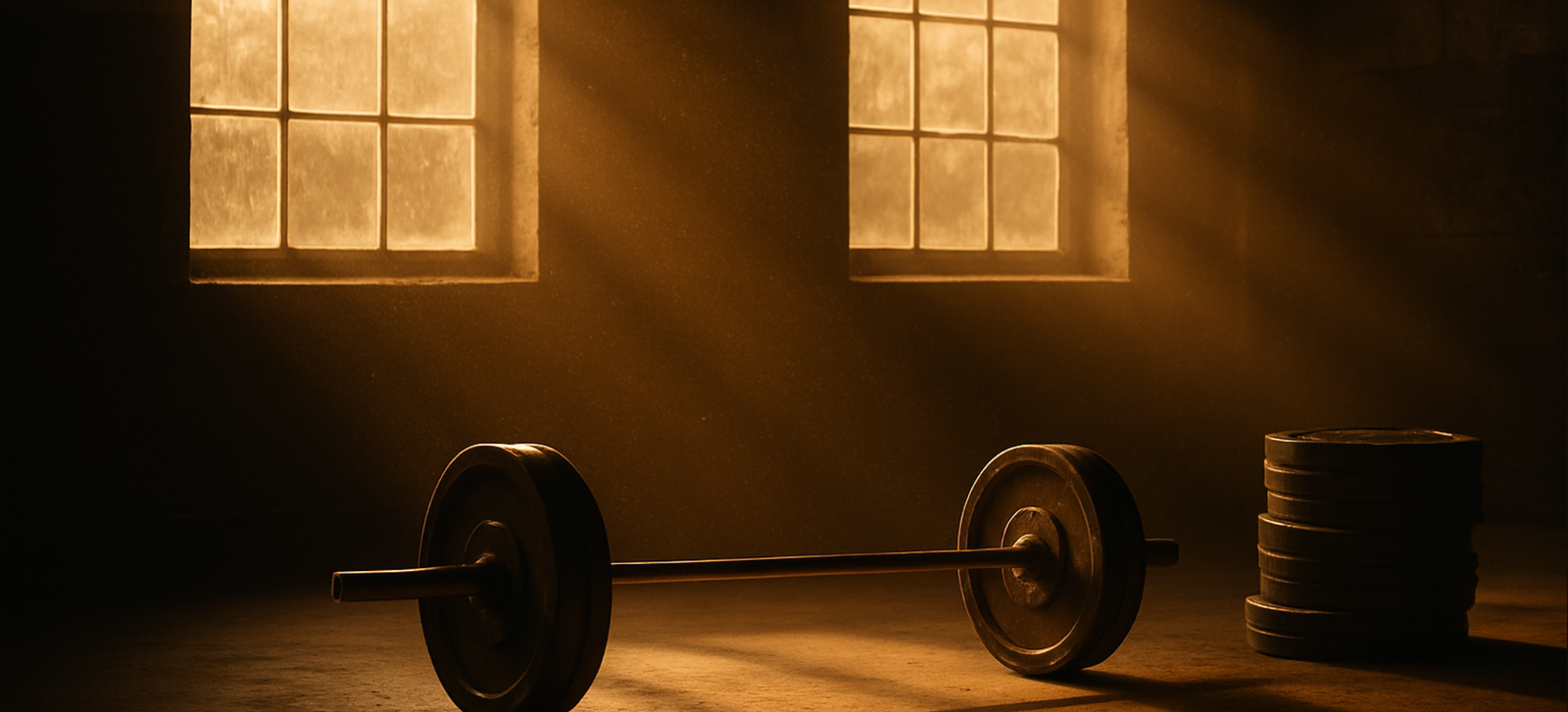Between the sweat and strain lies sacred silence. A raw exploration of finding the divine in deadlifts, discovering meditation in movement, and why the gym became my temple.
I was mid-set on deadlifts when it happened.
Rep seven of eight. The bar loaded with more weight than my ego thought I could handle. My hands were slipping. My back was screaming. Everything in me wanted to drop the weight and walk away.
But in that moment—between the inhale and the exhale, between the doubt and the decision—there was silence.
Not the absence of sound. The gymnasium was still full of clanking weights and grunting humans. But a deeper silence. The kind that exists in the space between thoughts, between heartbeats, between who you think you are and who you’re becoming.
That’s when I met God in the gym.
The Sacred Space We Don’t Talk About
Most people think of gyms as secular spaces. Places of vanity and ego. Temples to the physical, not the spiritual.
They’re wrong.
The gym is one of the few places left where we voluntarily embrace suffering. Where we choose discomfort. Where we practice the ancient art of pushing beyond our perceived limitations.
Sound familiar? Every spiritual tradition has been teaching this for thousands of years.
Buddhist teacher Pema Chödrön writes, “The most fundamental aggression to ourselves, the most fundamental harm we can do to ourselves, is to remain ignorant by not having the courage and the respect to look at ourselves honestly and gently.” <cite>¹</cite>
The gym strips away pretense faster than any meditation retreat. You can’t fake a deadlift. You can’t spiritually bypass a squat. The weight either moves or it doesn’t.
The Meditation of Iron
I started lifting weights at sixteen, not for enlightenment but for survival. Spina bifida had left me feeling broken, different, weak. The gym wasn’t spiritual sanctuary—it was physical therapy with a side of teenage angst.
But somewhere between the first awkward bench press and the thousandth practiced movement, something shifted.
The repetitive nature of lifting became meditative. The focus required to maintain proper form demanded presence. The rhythm of breath and movement created a moving meditation I never found sitting cross-legged on a cushion.
Neuroscientist Dr. Sara Lazar’s research at Massachusetts General Hospital found that physical practices requiring focused attention can actually change brain structure, increasing cortical thickness in areas associated with attention and sensory processing. <cite>²</cite> The gym, it turns out, was rewiring my brain for presence.
The Ego Death at 315 Pounds
There’s a particular weight where your ego dies.
For me, it was 315 pounds on the deadlift. Three plates on each side. A psychological barrier that had nothing to do with physics and everything to do with identity.
For months, I’d approach that weight and fail. Not because my body couldn’t handle it, but because my mind wouldn’t let go.
“I’m not strong enough.” “I’m not built for this.” “I’m the kid with spina bifida, not the guy who lifts heavy.”
The weight became a mirror, reflecting every limiting belief I’d ever held about myself.
Then one Tuesday morning, something shifted. Instead of approaching the bar with force, I approached it with surrender. Instead of trying to conquer the weight, I tried to dance with it.
Rumi wrote, “Try not to resist the changes that come your way. Instead, let life live through you. And do not worry that your life is turning upside down. How do you know that the side you are used to is better than the one to come?” <cite>³</cite>
That’s the moment the weight moved. Not because I got stronger, but because I got smaller. My ego stepped aside and something deeper took over.
The Cathedral of Sweat
The old gym I trained at for five years looked nothing like a cathedral. Cracked mirrors. Rusted equipment. A persistent smell of sweat and determination.
But it felt sacred.
There’s something about shared suffering that creates communion. The unspoken nod between strangers pushing their limits. The quiet encouragement when someone attempts a personal record. The way people spot each other—literally holding someone’s life in their hands—without ever exchanging names.
Anthropologist Arnold van Gennep identified three stages of ritual transformation: separation, transition, and reincorporation. <cite>⁴</cite> The gym perfectly embodies this process. You separate from your everyday identity, undergo the transition of physical challenge, and emerge reincorporated as a slightly different version of yourself.
The Breath Between Worlds
In powerlifting, there’s a technique called the Valsalva maneuver. You take a deep breath, hold it, and create internal pressure to stabilize your core during heavy lifts.
But it’s what happens after the rep that matters most.
The exhale. The release. The moment when you let go of the effort and simply breathe.
That’s where God lives. In the surrender after the struggle. In the stillness after the storm.
Yoga teacher B.K.S. Iyengar observed, “The rhythm of the body, the melody of the mind, and the harmony of the soul is hidden in the dance of breath.” <cite>⁵</cite> In the gym, this dance becomes tangible. Each rep is a prayer, each set a meditation, each workout a moving ceremony.
The Sacred Ordinary
I used to think spirituality required special clothes, incense, and Sanskrit mantras. The gym taught me it requires nothing more than honesty, effort, and the willingness to show up.
Some days, showing up looks like personal records and triumph. Other days, it looks like barely completing your warm-up and calling it enough.
Both are sacred.
Spiritual teacher Ram Dass taught that “we’re all just walking each other home.” <cite>⁶</cite> The gym is filled with people walking each other home—through encouragement, through example, through the simple act of sharing space with others who are also choosing to grow.
The Weight of Presence
After eight years of lifting, I’ve learned that the real weight isn’t in the plates. It’s in the presence required to stay focused when everything hurts. It’s in the trust required to attempt something you’ve never done before. It’s in the humility required to fail, rest, and try again.
Zen master Suzuki Roshi taught about “beginner’s mind”—approaching each moment with fresh eyes, regardless of experience. <cite>⁷</cite> In the gym, beginner’s mind isn’t optional. Every workout is different. Every rep demands attention. Arrogance gets you injured; presence keeps you safe.
The Resurrection After Rest
Rest days used to feel like failure. If I wasn’t pushing, grinding, growing, what was the point?
But the gym taught me about the holiness of rest. How muscle growth happens not during the workout but during recovery. How strength comes not from constant effort but from the rhythm of stress and restoration.
This is the divine paradox every mystic has discovered: sometimes you have to stop trying so hard to get where you’re going.
The Church of Iron and Humility
The gym became my church not because it was perfect, but because it was honest. It demanded truth from my body in ways that words never could. It taught me that spiritual growth isn’t always peaceful, gentle, or pretty.
Sometimes it’s sweaty, uncomfortable, and requires you to grunt through the hard parts.
Sometimes the divine meets you not in silence but in the clang of iron against iron.
Sometimes God speaks not in whispers but in the language of effort, persistence, and the sacred silence between reps.
The most profound spiritual truth I’ve learned in eight years of lifting is this: you don’t find God by escaping your body. You find God by fully inhabiting it.
One rep at a time. One breath at a time. One moment of presence at a time.
The weight will teach you everything you need to know about surrender, if you’re willing to listen.
If this resonated, there’s more where it came from.
Subscribe below for weekly doses of spiritual realism, fitness philosophy, and life lessons learned the hard way.
No BS. Just truth, served with a side of sarcasm and a whole lot of heart.
Your Tuesday morning coffee just got more interesting.
Citations:
- Chödrön, Pema. When Things Fall Apart: Heart Advice for Difficult Times. Shambhala Publications, 1997.
- Lazar, Sara W., et al. “Meditation experience is associated with increased cortical thickness.” NeuroReport, vol. 16, no. 17, 2005, pp. 1893-1897.
- Rumi, Jalal ad-Din. The Essential Rumi. Translated by Coleman Barks, HarperOne, 2004.
- van Gennep, Arnold. The Rites of Passage. University of Chicago Press, 1960.
- Iyengar, B.K.S. Light on Life: The Yoga Journey to Wholeness, Inner Peace, and Ultimate Freedom. Rodale Books, 2005.
- Dass, Ram. Be Here Now. Crown Publishing Group, 1971.
- Suzuki, Shunryu. Zen Mind, Beginner’s Mind. Shambhala Publications, 1970.


Leave a Reply